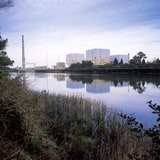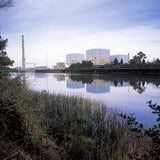Radioactive water contamination found at N.C. nuke plant

 The nuclear industry likes to promote itself as a clean energy source -- a message that's a key theme in its current public-relations offensive promoting its product as the environmentally benign alternative to dirty coal-fired power plants.
The nuclear industry likes to promote itself as a clean energy source -- a message that's a key theme in its current public-relations offensive promoting its product as the environmentally benign alternative to dirty coal-fired power plants.
But if nuclear energy is so "clean" and "non-polluting," how do its promoters explain the discovery this week of tritium-contaminated water on the grounds of Progress Energy's Brunswick nuclear power plant on the Cape Fear River south of Wilmington, N.C.?
A radioactive isotope of hydrogen, tritium occurs naturally in the environment at very low levels. It's also emitted during the operation of nuclear reactors, along with other radionuclides including cesium-137, iodine-131 and strontium-90. Biologically, tritium behaves like water, dispersing throughout the body and entering cells where it can have serious health effects, according to the nonprofit Nuclear Information and Resource Service:
Exposure to tritium has been clinically proven to cause cancer, genetic mutations and birth defects in laboratory animals. In studies conducted by Lawrence Livermore Laboratory in 1991, a comprehensive review of the carcinogenic, mutagenic and teratogenic effects of tritium exposure revealed that tritium packs 1.5 to 5 times more relative biological effectiveness (RBE), or biological change per unit of radiation (one rad or 0.01 gray), than gamma radiation or X-rays.
The tritium at Brunswick was discovered during a routine environmental check by Progress, in manholes near a pond that collects condensation from the plant's reactor cooling system and storm drain runoff, the State Port Pilot reports. While Progress employees work to trace the tritium to its source, a process expected to take about six weeks, company spokesperson Rick Kimble assures nearby residents there's nothing to worry about:
Kimble said Tuesday that, so far, there is no evidence that the radioactive element has made its way off plant property and into area waters.
"Tests from drinking water wells on-site show no traces of tritium, and we have no evidence that drinking water has been affected," Kimble said in a company statement e-mailed Tuesday. "The discovery of tritium in the areas identified does not pose a health or safety hazard to the public. Tests also indicate that the measurable tritium is confined within the plant's property boundaries."
However, that the contamination is limited to the plant property probably does little to ease the concerns of those who have to work there, including contract security guards responsible for patrolling the entire property.
The news comes the same week the environmental group Greenpeace released a report that found tritium from Canadian nuclear power plants is putting people at risk -- particularly young children and pregnant women. Because of the way they're designed and regulated, Canadian reactors release far more tritium into the environment than reactors in other countries -- 10 times higher than the release rates allowed in the United States and 100 times higher than allowed in Europe.
Tags
Sue Sturgis
Sue is the former editorial director of Facing South and the Institute for Southern Studies.
